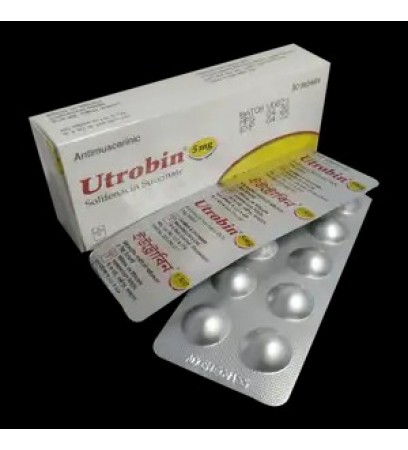Utrobin 5
- Brand:Unimed Unihealth Pharmaceuticals Ltd.
- Product Code: Solifenacin Succinate 5mg
- Availability: In Stock
-
14.25Tk.
Indications
Treatment for urge incontinence and/or increased urine frequency and urgency in patients with overactive bladder syndrome.
Pharmacology
Solifenacin is a muscarinic receptor antagonist that is competitive. It binds to M3, M1, and M2 muscarinic receptors with the greatest affinity. M2 receptors account for 80% of muscarinic receptors in the bladder, while M3 receptors account for 20%. Antagonism of the M3 receptor by solifenacin prevents detrusor muscle contraction, while antagonism of the M2 receptor may prevent bladder smooth muscle contraction.
Dosage & Administration
The recommended dose for adults and the elderly: Solifenacin Succinate 5 mg once daily. If needed, the dose may be increased to Solifenacin Succinate 10 mg once daily.
Use in children: Safety and effectiveness in children have not yet been established. Therefore, Solifenacin Succinate should not be used in children.
Interaction
Concomitant pharmaceutical with other restorative items with anticholinergic properties may result in more articulated helpful impacts and undesirable impacts. An interim of around one week ought to be permitted after ceasing treatment with Solifenacin Succinate some time recently commencing other anticholinergic treatment. The restorative impact of Solifenacin may be decreased by concomitant organization of cholinergic receptor agonists. Solifenacin can diminish the impact of restorative items that invigorate the motility of the gastrointestinal tract, such as Metoclopramide and Cisapride. In vitro ponders have illustrated that at restorative concentrations, Solifenacin does not hinder CYP1A1/2, 2C9, 2C19, 2D6, or 3A4 inferred from human liver microsomes. Subsequently, Solifenacin is improbable to modify the clearance of drugs metabolized by these CYP proteins. Solifenacin is metabolized by CYP3A4. Synchronous organization of Ketoconazole (200 mg/day), a powerful CYP3A4 inhibitor, come about in a two-fold increment of the AUC of Solifenacin, whereas Ketoconazole at a measurements of 400 mg/day brought about in a three-fold increment of the AUC of Solifenacin. Hence, the most extreme measurements of Solifenacin Succinate ought to be confined to 5 mg when utilized at the same time with Ketoconazole or helpful measurements of other strong CYP3A4 inhibitors (e.g. Ritonavir, Nelfinavir, Itraconazole).
Contraindications
Patients who are hypersensitive to solifenacin or any of the excipients should avoid using it. Myasthenia gravis, urinary retention, uncontrolled narrow angle glaucoma, severe gastro-intestinal conditions (including toxic megacolon), patients on haemodialysis, patients with severe hepatic impairment, patients with severe renal impairment or moderate hepatic impairment, and patients taking a strong CYP3A4 inhibitor, such as ketoconazole, are also contraindicated.
Side Effects
Due to the pharmacological impact of Solifenacin, it may cause anticholinergic undesirable impacts of (in common) mellow or direct seriousness. The recurrence of anticholinergic undesirable impacts is measurements related. The foremost commonly detailed unfavorable reactionwith Solifenacin is dry mouth. It happened in 11% of patients treated with 5 mg once every day, in 22% of patients treated with 10 mg once day by day and in 4% of placebo-treated patients. The seriousness of dry mouth was for the most part mellow and as it were once in a while driven to suspension of treatment. In general,medicinal item compliance was exceptionally tall (roughly 99%) and around 90% of the patients treated with Solifenacin completed the complete ponder period of 12 weeks treatment
Pregnancy & Lactation
No clinical information are accessible from ladies who got to be pregnant whereas taking Solifenacin. Creature ponders don't show coordinate hurtful impacts on ripeness, embryonal / fetal improvement or parturition. The potential hazard for people is obscure. Caution ought to be worked out when endorsing to pregnant ladies. No information on the excretion of Solifenacin in human drain are accessible. In mice, Solifenacin and/or its metabolites was excreted in drain, and caused a dosage subordinate disappointment to flourish in neonatal mice. The utilize of Solifenacin ought to hence be maintained a strategic distance from amid breast-feeding.
Precautions & Warnings
Other causes of visit urination (heart disappointment or renal malady) ought to be surveyed some time recently treatment with Solifenacin Succinate. In the event that urinary tract contamination is show, an fitting antibacterial treatment ought to be begun. Solifenacin Succinate ought to be utilized with caution in patients with: clinically noteworthy bladder outpouring hindrance at hazard of urinary maintenance, gastrointestinal obstructive clutters, hazard of diminished gastrointestinal motility, serious renal disability (creatinine clearance 30 ml/min), direct hepatic disability (Child-Pugh score of 7 to 9) and measurements ought to not surpass 5 mg for these patients.
Therapeutic Class
Anticholinergics (antimuscarinics)/ Anti-spasmodics, BPH/ Urinary maintenance/ Urinary incontinence)
Storage Conditions
Store in a cool and dry put, ensured from light.
Pharmaceutical Name
UniMed UniHealth Pharmaceuticals Ltd
Tags: Utrobin 5

